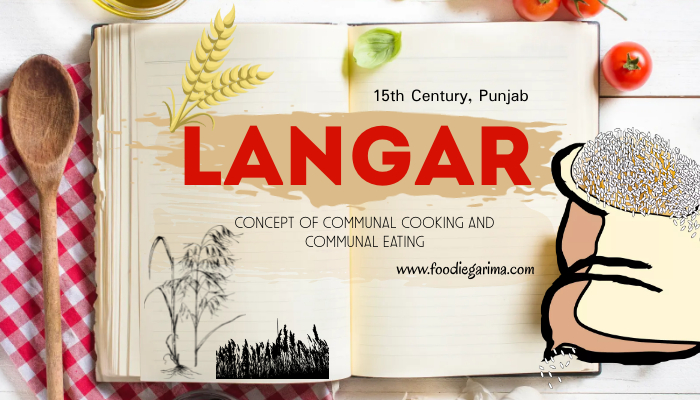4 February, 2023
LANGAR | Concept Of Communal Eating

Langar, 15th Century, Punjab.
What does ‘LANGAR’ mean?
‘Langar’ is the “Community Kitchen” which offers free meals to the needy people and everyone who visits Gurudwara (Sikh Temple). Besides providing free meals, its objective was to make sure that everyone sits together and eats together. People sit on the floor in rows as equals and eat together.
The core purpose behind starting ‘Langar’ was to feed everyone regardless of religion, caste, social class and gender. It breaks the barriers that we live with and ends all sorts of differences. This culture of ‘Langar’ which consists of communal cooking and communal eating, fights hunger and teaches equality. So it is actually more than a ‘Community Kitchen’.
‘Langar‘ which is a ‘Persian’ word and translates as an ‘Almshouse’ or a ‘place for the needy people’, was eventually incorporated into the Punjabi language.
‘Langar’ is being served in Gurudwaras all around the world on a daily basis. But, Have you ever wondered where all this money comes from to fund ‘Langar’?
Who Organises And Pays For It?
Volunteers (Sevadaars) organise the ‘Langar’ with devotion. Cooking food for thousands and sometimes for lakhs of people, is not an easy task. For centuries, it has been made possible due to people’s devotion only. It is basically prepared by a lot of people for a lot of people with lots of love. That’s what makes it delicious. People come here willingly and help in cleaning, chopping vegetables, preparing the meal and even serving it. By doing this Service (Sewa) devotees feel that they are serving their God.
‘Langar’ is funded by the ‘Sangat’ for the ‘Sangat’. People from various villages come and donate the one tenth part of their earnings or cultivated goods called ‘Dasvand’ at Gurudwara. They believe that one tenth part of their earnings or cultivated goods belong to God. All the donated goods are used for ‘Langar’ and finished on the same day. No goods are saved for the next day. This is how this ‘volunteer-run charitable feeding’ works.
.
Countless number of Sikhs and Hindus donate food grains like wheat, rice, lentils and vegetables etc. The principle of Langar is to donate whatever you can and to prepare holy food out of it. That’s why, technically there is no specific recipe for ‘Langar’ food.
‘Langar’ serves simple vegetarian food which is very pure and nourishing. It consists of Kada Prasad, Cooked Vegetables, Dal, Kheer (Rice Pudding cooked in sweetened milk), and sweets. Complete care is taken of purity, hygiene and cleanliness while cooking. No one can taste the food while cooking.
The strongest influence of this custom can be seen in Amritsar. The door of Harmandir Sahib Temple in Amritsar remains open 24 hours, not only to show devotees and pilgrims the path of spirituality but also to satiate their hunger.
On special occasions, devotees gather at their local Gurudwaras and help in preparations for ‘Langar’. All volunteers remain polite and hospitable to all the visitors.
We are actually feeding each other, serving each other and supporting each other through the concept of ‘Langar’.
Where Did The Concept Of Langar Come From?
The institution of ‘Langar’ was started over 500 years ago by the first Guru of Sikhs “Guru Nanak Dev Ji”, popularised by “Guru Angad Ji” and further encouraged by the third Guru of Sikhs “Guru Amar Das Ji’.
At that time, Guru Nanak Dev Ji’s father gave him 20 Rs. to conduct business and while he was on his way to do business he saw some hungry saints singing hymns. The saints didn’t have any food to eat. Then Guru Nanak Dev Ji bought some food with the money given to him by his father and fed those hungry saints. Since then, this practice is being followed by Sikhs.
When Akbar was the King of India, he came to meet the third Guru of Sikhs, Guru Amar Das Ji at the Goindwal Sahib Temple, which is near Amritsar in North Indian state Punjab. Guru Amar Das Ji had decreed that whoever comes to meet him will have to first partake at ‘Langar’. His objective was to promote equality among people and to get rid of the caste system.
Akbar also followed that custom. He sat on the floor and had a meal at ‘Langar’. He was so pleased that he donated some wealth and land so that ’Langar’ could be carried on.
This concept has now become an integral part of Sikh tradition.
To know more, Click here https://foodiegarima.com/food-stories/